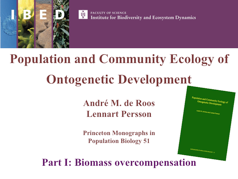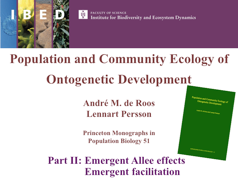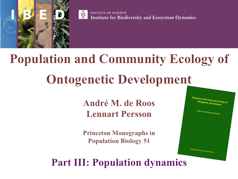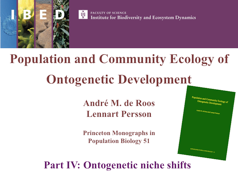Web seminars
These 4 seminars provide an overview of the most salient results published in the Princeton Monograph “Population and Community Ecology of Ontogenetic Development”. The first seminar lasts about 45 minutes, the other 3 last about 35 minutes. The last 3 seminars can in principal be watched in arbitrary order, but it is necessary to look at the first webinar before watching any of the others. Alternatively, you can also watch the presentation by my colleague, friend and co-author on this monograph, Lennart Persson of Umeå University, Sweden.Part 1: Ontogenetic asymmetry
In this seminar I introduce the simple, but very basic idea that has been the main reason to write the Princeton Monograph: existing theory on population and community ecology has neglected the most important process in individual life history, individual development, that distinguishes individual organisms from elementary entities in other fields of science, such as physics and chemistry. Development, with as its most important aspect growth in body size, is at par with reproduction and mortality and can even be considered to be the most important life history process after mortality.The most important consequence of taking into account development next to reproduction is that it gives rise to ontogenetic asymmetry in energetics between individuals in different stages of their life. The novel concepts of ontogenetic symmetry and asymmetry are explained in detail and it is shown how ontogenetic asymmetry leads to biomass overcompensation, the counter-intuitive effect that biomass may in fact increase with increasing mortality. Finally, the available empirical and experimental evidence for biomass overcompensation is presented.
Part 2: Community consequences
In this part I present the most important consequences of biomass overcompensation for the structure of ecological communities. These include emergent Allee effects for stage-specific predators and emergent facilitation between predators species that forage on different ranges of a prey body size-distribution. I furthermore present empirical and experimental evidence for the occurrences of these community consequences in natural systems. In particular, I argue that they may be responsible for a lack of recovery of piscivorous fish stocks after collapsing due to over-harvesting.Part 3: Population dynamics
In this seminar I discuss the consequences of ontogenetic asymmetry in energetics for population dynamics. Ontogenetic asymmetry is shown to be at the basis of the occurrence of generation cycles, which are fluctuations in population abundance that are related to the developmental process of the individual organisms. In contrast to classic predator-prey cycles, these fluctuations have a period that is equal to or slightly larger than the time it takes juvenile individuals to reach maturity. Depending on the type of ontogenetic asymmetry in energetics these generation cycles can either be juvenile-driven or adult-driven cycles, when either juveniles or adults, respectively, are more efficient in their use of resources for biomass growth.Part 4: Ontogenetic niche shifts
Most animal species are characterized by complex life cycles that unfold as a series of distinct stages. The different stages may be morphologically very different and separated by metamorphosis, such as in amphibians and insects, or may only be ecologically very different, such as in piscivorous fish species that substantially grow in body size during life. An important aspect of both forms of complex life cycles is that individuals use different resources in different life history stages and exhibit a so-called ontogenetic niche shift in between. This seminar highlights the community consequences of ontogenetic niche shifts.Ontogenetic niche shifts in prey populations may induce that predators that forage on a particular life stage of prey go extinct when the productivity of the resource for that prey life stage increases. This inverse bottom-up effect we refer to as emergent predator exclusion. Another counter-intuitive and very surprising consequence of an ontogenetic niche shift is that it allows a species that is both an inferior competitor and more sensitive to predation to nonetheless drive a superior competitor to extinction. The mechanism giving rise to this so-called dominance of the double-handicapped consumer is explained.
Video: Symmetry breaking in ecological systems
Seminar: Symmetry breaking in ecological systems through different energetic efficiencies of juveniles and adults – a new paradigm unfolds?Lennart Persson, professor in Aquatic Ecology, Umeå University, Sweden.



